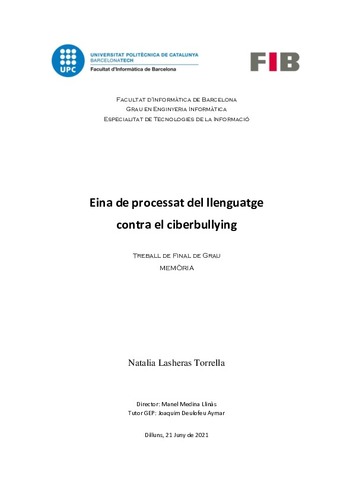Mostra el registre d'ítem simple
Eina de processat del llenguatge contra el ciberbulling
| dc.contributor | Medina Llinàs, Manel |
| dc.contributor.author | Lasheras Torrella, Natalia |
| dc.contributor.other | Universitat Politècnica de Catalunya. Departament d'Arquitectura de Computadors |
| dc.date.accessioned | 2021-09-22T18:12:48Z |
| dc.date.available | 2021-09-22T18:12:48Z |
| dc.date.issued | 2021-06-21 |
| dc.identifier.uri | http://hdl.handle.net/2117/352120 |
| dc.description.abstract | L'increment de casos de ciberbullying en la actualitat i especialment en menors és un fenomen preocupant que ve donat per l'ús constant i en augment de les xarxes socials així com l'anonimat que aquestes s'ofereixen. Aquest projecte busca explorar la possibilitat de detecció de ciberbullying en missatges escrits en català, no per paraules claus sinó entenent la intencionalitat de la oració escrita, per a oferir una alternativa més efectiva que aquesta i més innovadora. Per a fer-ho es busca una solució orientada en el camp de deep learning de manera que es generi un model que mitjançant tècniques del processat de llenguatge natural pugui determinar la probabilitat de que el missatge analitzat tingui intencionalitat d'assetjar online. Així doncs, es genera el nostre propi data set així com el nostre propi model el qual es contrasta amb altres classificadors existents per a poder realitzar un anàlisis i generar un model que doni solució a la qüestió amb el major percentatge de predicció possible. |
| dc.description.abstract | The increase of cases of ciberbullying in the current climate and specially in under age kids, is a worrisome phenomenon brought on by the constant and rising use of social networks and the anonymity those provide to perpetrators. This project searches to explore the possibility of detection of ciberbullying situations in messages written in Catalan, not by the identification of key words but by understanding the intention behind the text written, in order to offer a better and more innovative alternative to the solutions explored nowadays. In order to do so we search for a solution focused in the field of deep learning in order to generate a model that by the use of natural processing of the language techniques allows us to determine the probability of a message being of ill-intentioned and therefore creating a new tool to battle this ever present situation. We do so by creating our own dataset as well as our own predictive model which will be contrasted with different pre-existent classifiers will be analyzed so we can create a model that solves this problematic with the highest success rate possible. |
| dc.language.iso | cat |
| dc.publisher | Universitat Politècnica de Catalunya |
| dc.subject | Àrees temàtiques de la UPC::Informàtica |
| dc.subject.lcsh | Natural language processing (Computer science) |
| dc.subject.lcsh | Machine learning |
| dc.subject.other | Deep Learning |
| dc.subject.other | Machine Learning |
| dc.subject.other | Dataset |
| dc.subject.other | Classificadors |
| dc.subject.other | Model |
| dc.subject.other | Pre-processat de text |
| dc.subject.other | Processat del Llenguatge Natural |
| dc.subject.other | Aprenentatge autònom |
| dc.subject.other | Entrenament |
| dc.subject.other | Ciberbullying |
| dc.subject.other | Detecció |
| dc.subject.other | Aprenentatge supervisat |
| dc.subject.other | Natural Language Processing |
| dc.subject.other | Autonomous learning |
| dc.subject.other | Training |
| dc.subject.other | Ciberbullying |
| dc.subject.other | Detection |
| dc.subject.other | Supervised learning |
| dc.title | Eina de processat del llenguatge contra el ciberbulling |
| dc.type | Bachelor thesis |
| dc.subject.lemac | Tractament del llenguatge natural (Informàtica) |
| dc.subject.lemac | Aprenentatge automàtic |
| dc.identifier.slug | 160752 |
| dc.rights.access | Open Access |
| dc.date.updated | 2021-07-05T04:02:59Z |
| dc.audience.educationlevel | Grau |
| dc.audience.mediator | Facultat d'Informàtica de Barcelona |
| dc.audience.degree | GRAU EN ENGINYERIA INFORMÀTICA (Pla 2010) |


